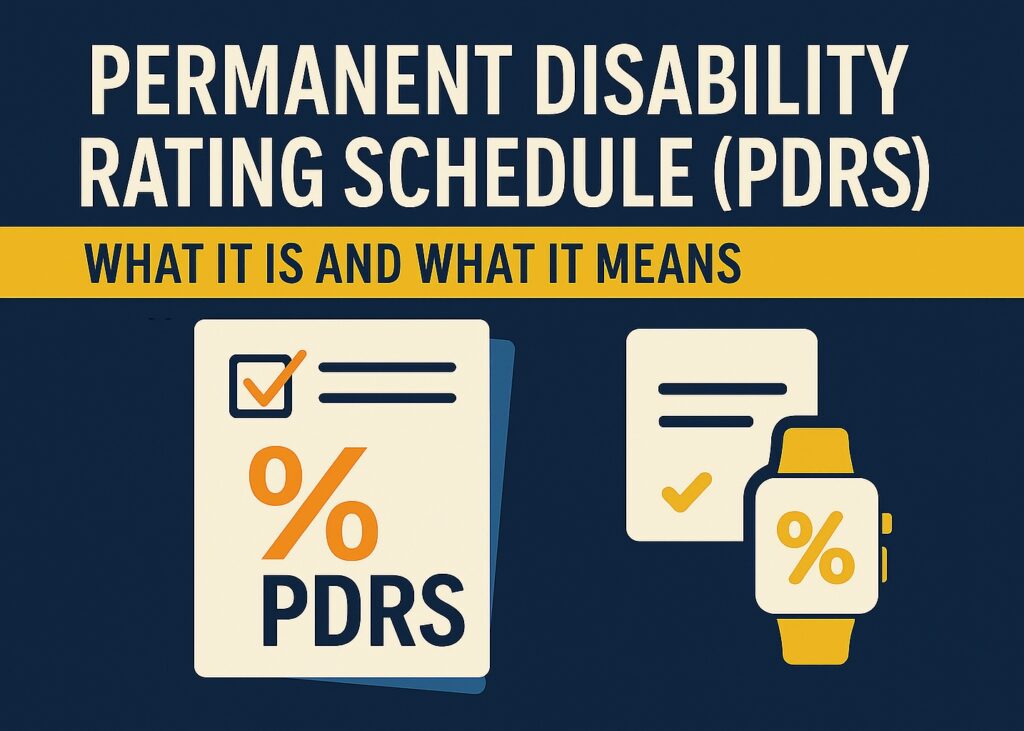
What Is the Permanent Disability Rating Schedule (PDRS)?
The Permanent Disability Rating Schedule (PDRS) is a legal framework used in California to quantify how much a work injury has impaired an individual’s ability to earn a living. It converts medical findings into a percentage of permanent disability—a number that drives how long and how much a worker receives in Permanent Disability (PD) benefits.
The PDRS is more than a formula. It is the foundation of how insurance companies, judges, and lawyers value your injury. And because the process is both medically and legally technical, many workers unknowingly accept lower PD ratings—and smaller settlements—than they deserve.
At Employees First Labor Law, we work to ensure that our clients’ disability ratings reflect their real-world limitations, not just what’s typed in a QME report.
Why Your Permanent Disability Rating Matters
The permanent disability rating (PD rating) is one of the most important numbers in your workers’ compensation case. It determines:
- Total compensation you’re owed for your injury
- How long you will receive weekly PD payments
- Whether you qualify for a Supplemental Job Displacement Voucher (SJDB)
- Whether you’re entitled to future medical care
- Your negotiating leverage during settlement talks
- Whether your injury qualifies as 100% permanent disability (lifetime benefits)
Even a 5% increase in your PD rating can mean tens of thousands of dollars more in your case value.
How Is the PD Rating Calculated?
The PD rating process involves 5 key steps under the PDRS:
- Whole Person Impairment (WPI):
A doctor—either your Primary Treating Physician (PTP), Qualified Medical Evaluator (QME), or Agreed Medical Evaluator (AME)—assigns a percentage of impairment based on the AMA Guides (5th Edition). - Adjustments for Age & Occupation:
The WPI is modified to account for your age at the time of injury and your job classification, using predefined tables in the PDRS. - Diminished Future Earning Capacity (DFEC) Modifier:
- For injuries between 2005–2012: DFEC adjustment applied.
- For injuries after January 1, 2013: DFEC is no longer used; the system follows a stricter AMA-based impairment model.
- Apportionment:
Doctors may assign a portion of your disability to non-industrial causes (e.g., aging, prior injuries), which reduces your final rating unless successfully challenged. - Final PD Rating:
The adjusted figure becomes your final PD rating, which determines the number of weeks of compensation you receive and whether you qualify for further benefits.
What Version of the PDRS Applies to You?
- 1. Injuries before 2005: Governed by the 1997 PDRS
- 2. Injuries from 2005–2012: Governed by the 2005 PDRS (includes DFEC adjustment)
- 3. Injuries from 2013 onward: Governed by the current version, which excludes DFEC and follows stricter AMA criteria
Most injured workers today fall under the post-2013 rules, which are notoriously unfavorable unless challenged with skilled legal representation.
Common Issues with PD Ratings
Too often, injured workers are assigned inaccurately low ratings because:
- QMEs or PTPs misapply the AMA Guides
- Reports omit functional impairments like pain, loss of strength, or psychological injury
- Doctors are pressured to declare premature MMI
- Apportionment is inflated unfairly to reduce benefits
- Insurers deny symptoms not visible on imaging
Key red flags to watch out for in your PD report:
- No mention of pain, despite chronic complaints
- No explanation of job-specific limitations (e.g., bending, typing, lifting)
- Language suggesting your injury is “pre-existing” or “degenerative”
EFLL regularly audits medical reports and demands corrections or second opinions when necessary.
How Ratings Impact Settlements – Sample Scenarios
| Injury Type | WPI % | Adjusted PD Rating | Est. Case Value* |
|---|---|---|---|
| Lumbar spine (moderate) | 13% | 15% – 18% | $20,000 – $30,000 |
| Carpal tunnel w/ surgery | 10% | 12% – 15% | $15,000 – $25,000 |
| Knee replacement | 30% | 35% – 40% | $50,000 – $75,000 |
| CRPS / Neuropathy | 50%+ | 60% – 80%+ | $100,000 – $500,000+ |
*These estimates vary based on weekly wages, medical care rights, and legal representation.
How EFLL Maximizes Your PD Rating
Our experienced legal team takes a multi-pronged approach to fight for higher ratings:
- ✅ Challenge low MMI determinations to ensure full treatment is completed
- ✅ Request AME evaluations when QME reports are unfair or incomplete
- ✅ Cross-examine doctors during depositions to expose flawed methodology
- ✅ Correct apportionment errors that reduce your rating
- ✅ Include additional impairments, such as mental health, sexual dysfunction, or chronic pain, when applicable
We’ve helped workers increase their PD ratings from 12% to over 45%, unlocking six-figure settlements that insurers tried to deny.

Final Thoughts
The Permanent Disability Rating Schedule is more than a technical process—it’s a legal battleground that can define the rest of your financial life after an injury.



